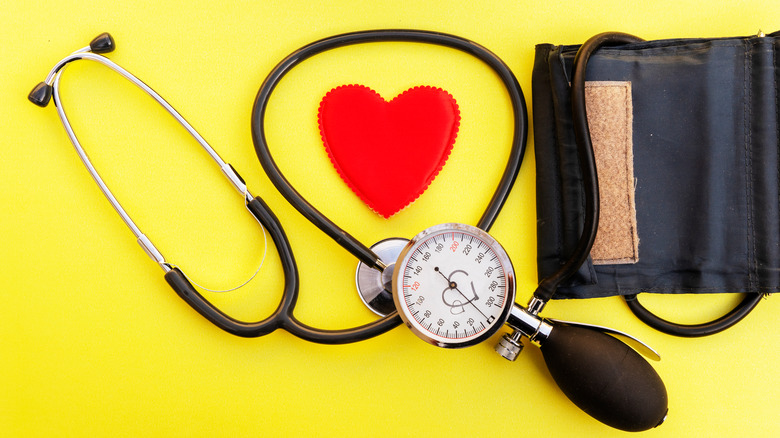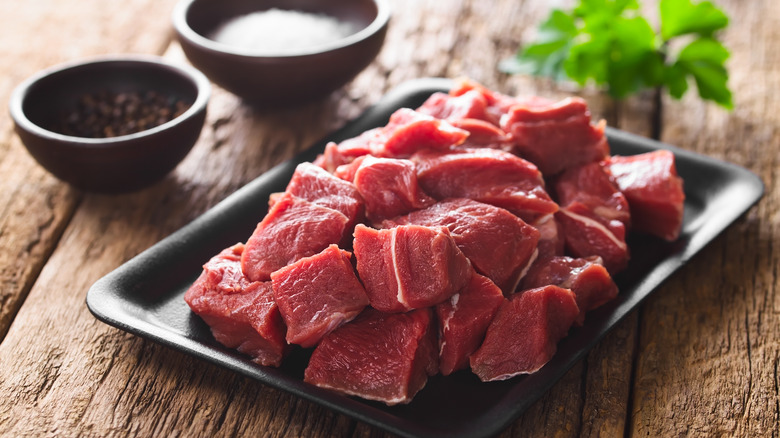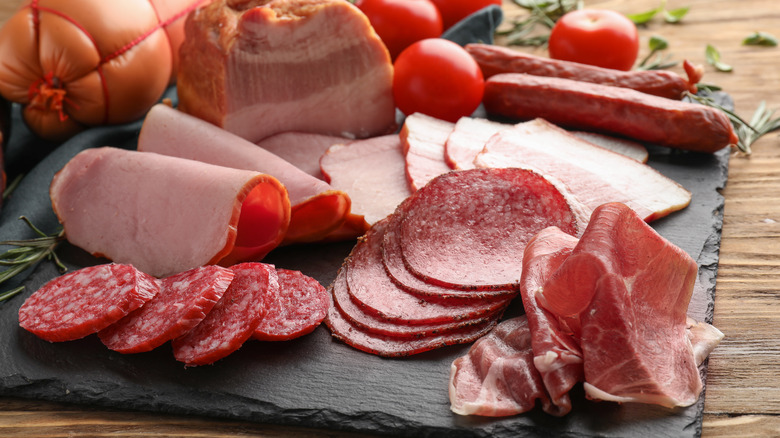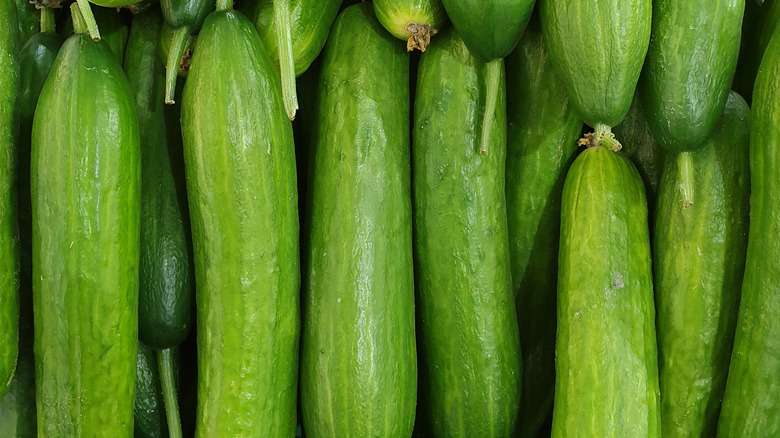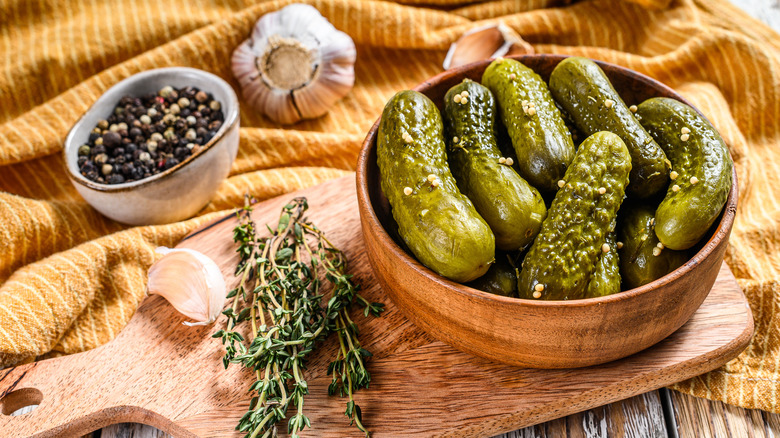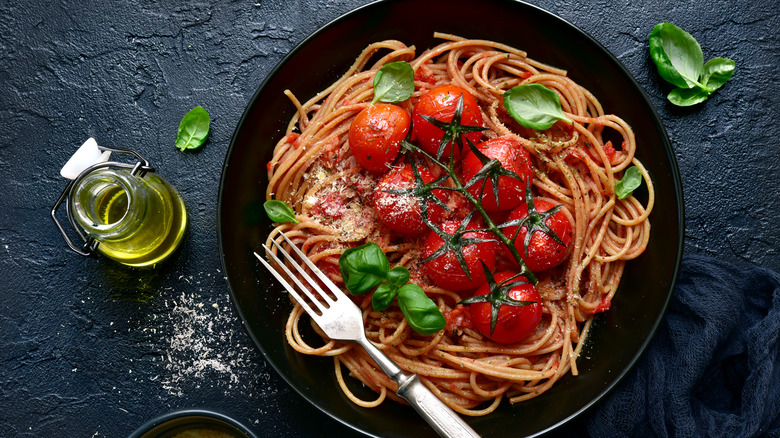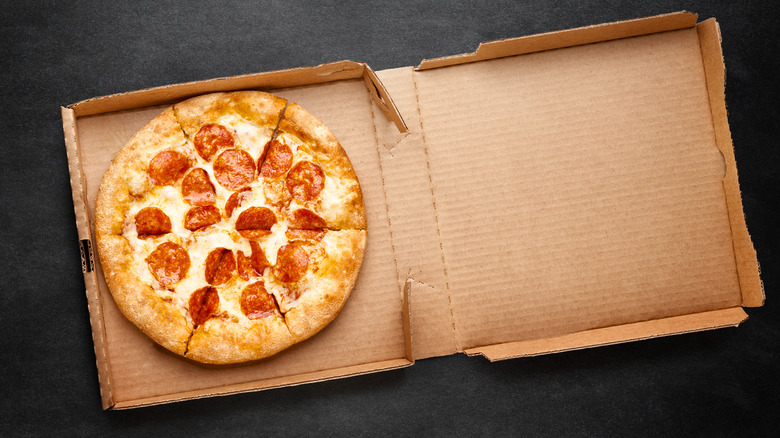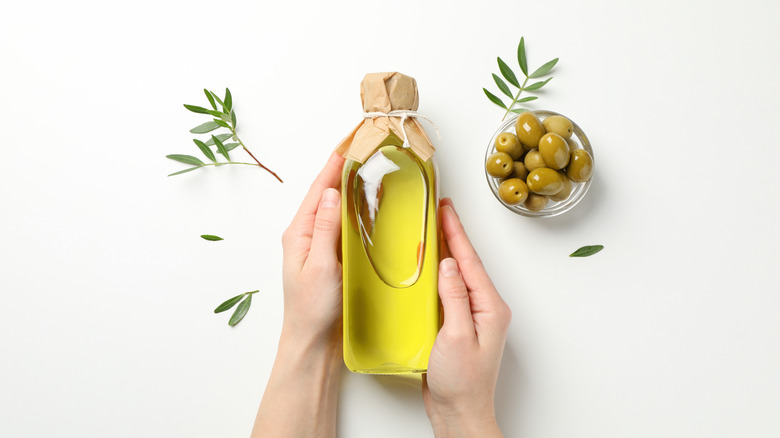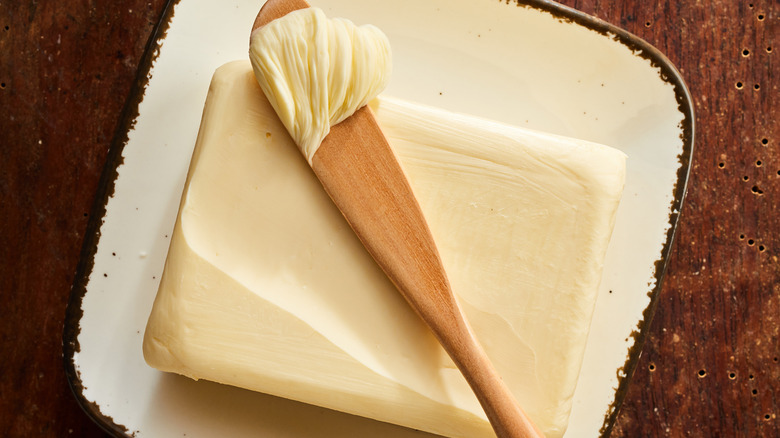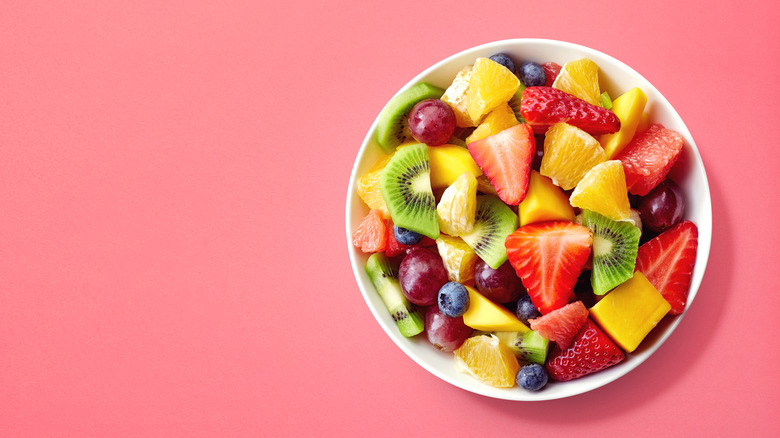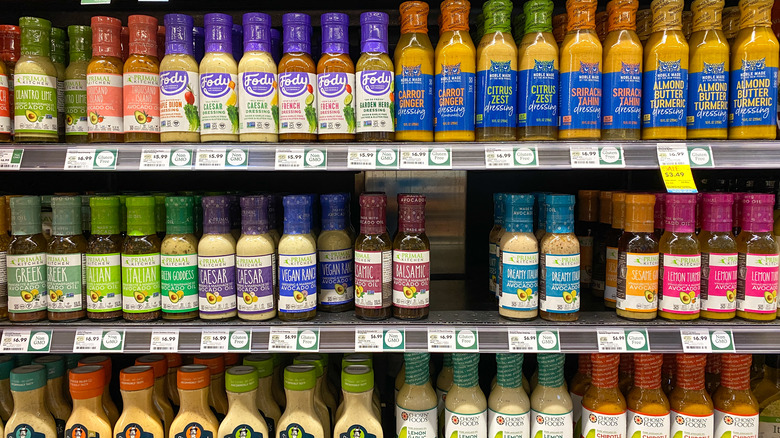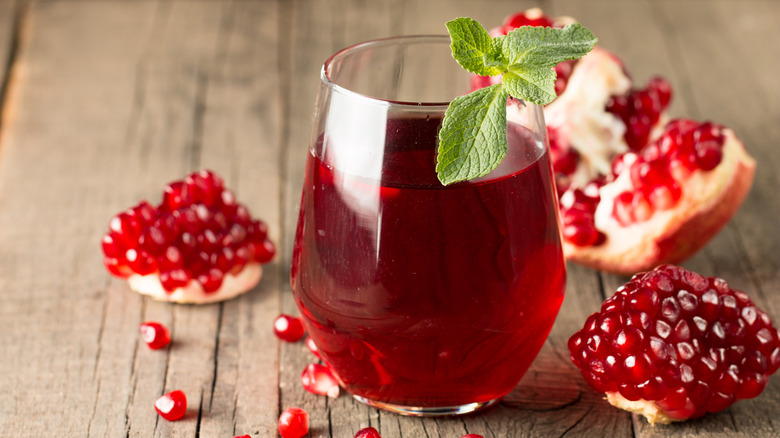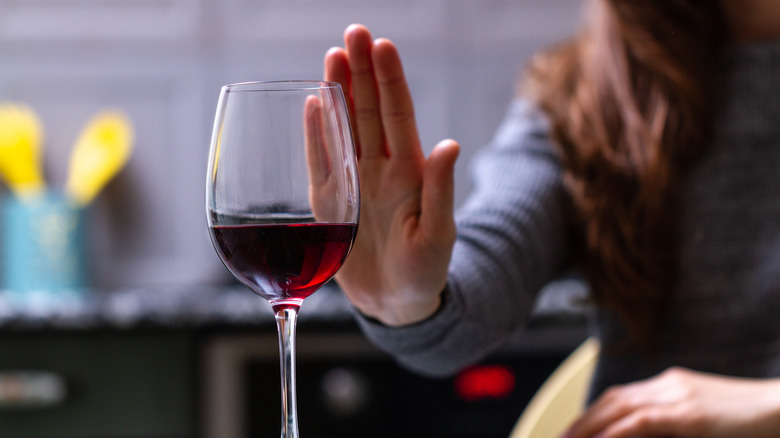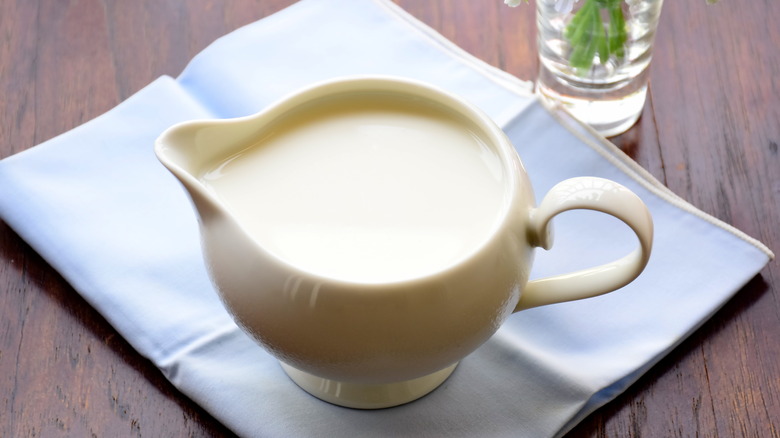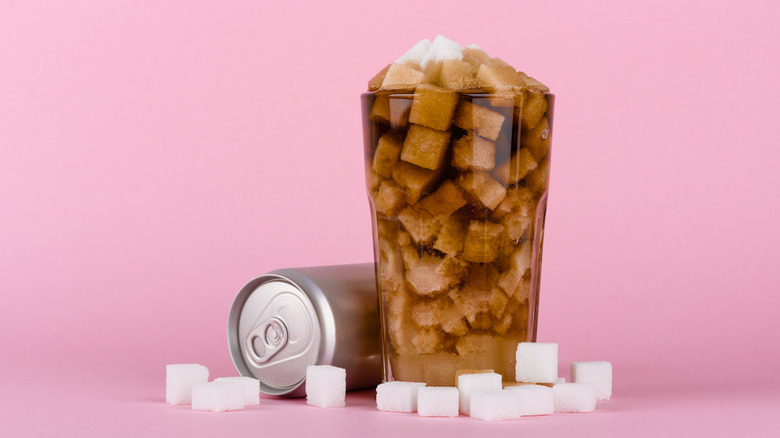7 Foods To Eat And 7 To Avoid If You Have High Blood Pressure
High blood pressure (or hypertension) amongst adults is frighteningly common. In the USA, almost half of all adults have high blood pressure, with the condition acting as a primary or contributing cause of death for almost a half-million people in 2018, according to the CDC. As a condition that can lead to a wealth of profound health issues, such as a stroke, heart attack, and kidney damage, finding ways to control your blood pressure is crucial; yet as the CDC shows, fewer than one in four adults who have hypertension are actively controlling their condition.
And, as with most things, it all starts with what we eat. If you've been diagnosed with high blood pressure, following specific diets like the DASH (Dietary Approaches to Stop Hypertension) diet, a diet program that limits high-sodium, high-saturated fat foods and promotes choices that provide blood-pressure-friendly nutrients, as the Mayo Clinic states, is a wise and healthy idea. But, if completely revolutionizing your diet feels daunting, don't fret. At Health Digest, we've put together a simple starter guide, with seven foods to eat and seven to avoid, if hypertension is a concern. Let's take a look at our top picks.
Eat: Lean beef
Beef often gets a very bad rap when it comes to blood pressure, with the meat (and other red meats) often cited as contributing to higher cholesterol and higher blood pressure, as Everyday Health says. However, when it comes to red meat, it may all be in the cut you choose, and how much you eat. "Lean cuts of beef, in smaller portions, can be part of a healthy lifestyle," states registered dietitian Justine Hays, who practices in Buffalo, New York, to Livestrong. "These cuts of beef, much like lean poultry and seafood, can provide nutrients such as protein, iron, vitamin B, and zinc."
When lean beef is included in a DASH-style diet, emphasizing foods that can help to control blood pressure, it's been shown to contribute towards better blood pressure levels. A study published in the Journal of Human Hypertension found that a "moderate-protein, DASH-like diet including lean beef decreased SBP [systolic blood pressure] in normotensive individuals," with "normotensive" meaning those who had normal blood pressure already, states MedicineNet. As such, when choosing your meat, try and avoid cuts that could contain higher levels of saturated fats.
Avoid: Deli meat
There's no denying it: the salty, sharp taste of deli meat is delicious. Unfortunately, it's also your blood pressure's worst enemy. "In general, deli meats can be a convenient, pre-cooked source of protein. However, consuming multiple servings a week might pose a risk for those with high blood pressure, heart disease, or women who are pregnant," advises registered dietitian and owner of Stirlist, Amber Pankonin, to Eat This, Not That!. These meats are, more often than not, highly processed, and contain a huge amount of sodium — the consumption of which is a huge risk factor for elevated blood pressure.
With just one ounce of deli turkey meat (often considered to be healthy due to its lower fat content) containing more than 500 milligrams of sodium, according to Eating Well, it's a huge amount in such a small serving. Instead, try and look for low-sodium options, or cook the meat yourself so you can control the level of sodium present in what you're eating. Watching your sodium applies to everything you're consuming if you already have high blood pressure, says Pankonin. "Monitor blood pressure levels regularly and choose foods and beverages that are lower in sodium," she adds.
Eat: Cucumbers
Who'd have thought that the humble cucumber could be so beneficial for your blood pressure? It's all down to their unique balance of potassium and sodium, according to Livestrong. One cup of sliced cucumber contains around 4% of your daily recommended intake for potassium, says Live Science, as well as great levels of vitamin K, almost no sodium, and much fewer calories than other foods of equivalent potassium levels. Potassium is not only important for hydration but can also help to keep blood pressure controlled and lower the risk of heart disease.
There's also the fact that eating higher amounts of cucumber, as well as other fruits and vegetables, can help curb hunger levels, making weight management easier, as California-based dietitian Vandana Sheth says — and weight loss and control can be a huge factor in managing blood pressure. You don't even have to eat cucumber whole to reap the benefits, either. A study conducted by Public Health of Indonesia found that drinking cucumber juice had a significant effect on lowering blood pressure among the elderly (although the study's authors do indicate that further study is needed to examine this effect in more detail).
Avoid: Pickles
While cucumbers can be great for blood pressure, once they morph into their saltier, more-sour pickle form, it might be game over. Pickles are pretty bad for blood pressure, due to the high levels of sodium that are present in most pickle products, states WebMD. A single pickle spear can contain around 326 milligrams of sodium, according to the USDA. When you consider that the daily recommended sodium intake for adults is 2,300 milligrams or less (per the FDA), that's an extraordinary amount of sodium for something you can eat in just a bite or two.
An Iranian study published in Clinical Nutrition Research seems to confirm the link between higher blood pressure and pickles. The study found that there seemed to be a "significant association" between the consumption of pickles and higher blood pressure, as well as obesity. The higher levels of sodium in pickles (and other pickled vegetables aside from just pickled cucumbers) can also lead to added strain on the liver and kidneys. If you're a big pickle fan, try and seek out low-sodium options, or you can make them at home pretty easily with much less sodium than store-bought, as Diabetes Food Hub shows how to do.
Eat: Whole-grain pasta
This one might have a few folks breathing a sigh of relief: yes, pasta is not off the menu if you have high blood pressure. Just make sure it's whole-grain. According to the Mayo Clinic, the DASH diet, as well as the heart-healthy Mediterranean diet, both recommend consuming approximately three ounces a day of whole grains, including whole-grain pasta, as part of your daily intake. These fiber- and nutrient-rich grains come loaded with potassium and can help to reduce blood vessel damage and lower your chance of insulin resistance — all contributing towards healthier blood pressure.
However, if you're choosing whole-grain pasta, watch what you're pairing it with. Jarred pasta sauces can be pretty much the worst thing for your blood pressure, due to their sometimes extraordinary amount of sodium per serving. Some spaghetti sauces can have 1,000 milligrams of sodium per cup serving, states Everyday Health, almost half of an adult's recommended daily intake. Instead, seek out sauces that are low-sodium or make your own at home, and try to keep in the spirit of the DASH or Mediterranean diets by pairing your pasta with fresh vegetables instead of high-fat meats.
Avoid: Pizza
We know. We're sorry. We hate being the bearers of bad news. Put pizza is often not going to be your best friend if you have high blood pressure. A huge part of what makes pizza so delicious is the cheese and the sauce, both of which can often be loaded with sodium, according to Livestrong. So if you're eating out at a chain restaurant, a simple cheese pizza can contain anywhere between 400 to 900 milligrams of sodium per slice; start adding salty cured meats like pepperoni, and this can skyrocket to over 1,000 milligrams per slice.
This sodium can wreak havoc on your blood pressure by causing our bodies to hold on to extra water, causing blood pressure to rise, and creating extra stress on our blood vessels and heart, states the Cleveland Clinic. And, if you're thinking "Fine, I'll just eat in," frozen pizza's not really any better. One serving of DiGiorno's frozen pizza can deliver a whopping 840 milligrams of sodium, as well as high levels of saturated fat, sugar, and refined carbohydrates, according to Eat This, Not That!. It's important to remember that even if you're trying to control your blood pressure (ideally by consuming less than 1,500 milligrams of sodium per day, per the American Heart Association, you can still treat yourself to a slice now and again. Just make sure you're planning for the sodium you're consuming.
Eat: Extra-virgin olive oil
If you could distill pure goodness into a liquid, it'd probably look a little like olive oil. A mainstay of the Mediterranean diet, olive oil's monounsaturated fats are heart-healthy and can help to reduce blood clotting, as well as the risk of heart disease and stroke. For the cream of the health crop, extra-virgin olive oil is the top choice, not least for its effects on blood pressure.
A study published in Archives of Internal Medicine (via WebMD) looked at the effects of substituting extra-virgin olive oil for other types of fat on the blood pressure of those taking medication for hypertension, and found that it had an excellent impact. "The most important finding in this study is that the daily use of olive oil, about 40 grams per day, markedly reduces the dosage of [blood pressure medication] by about 50% in hypertensive patients on a previously stable drug dosage," said the study's lead author, L. Aldo Ferrara, University of Naples Federico II's associate professor of internal medicine. Ferrara and his fellow study authors think this effect might be down to olive oil's high polyphenol content, although more research may be needed to corroborate this.
Avoid: Butter
Fats are, for better or worse, not created equal. While monounsaturated fats (such as olive oil) may contribute to a lowering of blood pressure, other fats may not be as beneficial in this respect. Butter is one of these. While saturated fats like butter may not necessarily cause high blood pressure in and of themselves, they can cause a raising of blood cholesterol and, specifically, of 'bad' HDL cholesterol, which can clog your arteries and cause further complications if you have high blood pressure already, says Blood Pressure UK.
For this reason, eating saturated fats, such as those found in butter, in high quantities is best avoided if you have high blood pressure, and will help you control your blood pressure in the long run. The same goes for saturated fats that are found in other dairy products, like cream and cheese. Instead, choosing unsaturated fats, like those found in avocados, oily fish, and olive oil, can help you to regulate your blood pressure. It's important to remember that not all cholesterol is bad. Some 'good' LDL cholesterol, like those found in unsaturated fats, is essential for your blood to function properly.
Eat: Fruit salad
If you're a fan of fruit salad, you're in luck: those with high blood pressure can feasibly include this as part of their diet. In particular, fruit salads that contain potassium-rich fruits like bananas, grapefruit, apricot, and melon are all fantastic choices if you're trying to keep your blood pressure controlled or lower it, as the American Heart Association states. This is due to potassium's effects on sodium. Eating more potassium means you lose more sodium through your urine, which then means it has less of an effect on your blood pressure. It also helps to make your blood vessel walls less tense, to which sodium can contribute, again helping to keep blood pressure lower.
If you want to maximize your fruit salad's effect on your blood pressure, try pairing it with orange juice. A study published in the journal ARYA Therosclerosis looked at the effects of drinking orange juice on blood pressure and, interestingly, found that commercial orange juice (the kind you get in a carton) significantly reduces blood pressure. This could be due to the higher levels of flavonoids and pectin found in commercial orange juice products.
Avoid: Bottled salad dressings
A healthy salad, packed full of vegetables, will do your blood pressure nothing but good — until you pour the wrong salad dressing on it. While you may not think so (because they go on, well, salad), bottled salad dressings can be surprisingly unhealthy due to the high levels of sodium (and sugar) present in some products, which can wreak havoc on your blood pressure. This is particularly the case with low-fat or low-cal dressings, which add huge amounts of sodium to boost flavor. Girard's Champagne 60-Calorie Vinaigrette, for example, may be low in calories, but contains 440 milligrams of sodium per serving — nearly a quarter of your daily intake, says Eat This, Not That!.
Marzetti Fat-Free Sweet & Sour Dressing, similarly, is branded as fat-free, but contains not only 300 milligrams of sodium per serving, but also 10 grams of sugar. Sugar can play a powerful role in keeping blood pressure high, by stopping nitric oxide production, which is vital in keeping blood vessels dilated and blood pressure controlled, as Verywell Health states. Instead of reaching for unhealthy (and pricey!) salad dressings on the shelves, you can whip up a simple vinaigrette in no time.
Drink: Pomegranate juice
Eating pomegranates can be fiddly business, with the endless seed-scooping you have to undertake. By opting for pomegranate juice instead, you can get many of the benefits of the fruit without the hassle, and your blood pressure will thank you for it. Pomegranates and their juice are high in antioxidants called anthocyanins, explains registered dietitian and nutrition teacher Sarah Pflugradt to Eating Well. These antioxidants can provide a bevy of benefits, particularly in the reduction of low-grade chronic inflammation, which Pflugradt says "is known to be a root cause of many chronic conditions, such as heart disease, high blood pressure, and type 2 diabetes."
Pomegranate juice's potential effect on blood pressure in particular has been well-observed in several recent studies, says Pflugradt. One study, published in Clinical Nutrition, followed patients who drank pomegranate juice over a period of three years. The study found that not only did drinking pomegranate juice seem to contribute towards the reduction of LDL cholesterol, but blood pressure was reduced by 12% in patients after just one year of drinking the juice. While this was a small study, reviews in Complimentary Therapies in Clinical Practice have noted similar associations.
Avoid: Alcohol
Alcohol is a relaxant and, so, it makes sense that we might assume it relaxes our heart rate and our blood pressure, too. There's also a wealth of thought out there that says that drinking alcohol in low quantities can be good for our heart health although, as Johns Hopkins Medicine points out, it's hard to determine the cause and effect from the studies that show this.
When it comes to the link between alcohol and blood pressure, however, it's more complicated, and not altogether a happy picture. As the Mayo Clinic points out, drinking more than three drinks in one sitting can cause your blood pressure to rise temporarily. Doing this repeatedly, however, or binge drinking in more excessive quantities, can cause longer-term increases. If you already have high blood pressure and are taking medication for it, drinking can also interact with them, causing complications.
While you might be thinking "sure, but a little bit can't hurt my blood pressure, right?", that may not even be the case. A recent study of more than 17,000 people found that even moderate alcohol consumption can notably increase your risk of hypertension, with 'moderate' defined as consuming seven to 13 drinks per week, as Science Daily reports.
Drink: Skim milk
It might not be the first drink you think of when it comes to controlling high blood pressure, but skim milk could be your greatest ally in keeping hypertension at bay. Low-fat dairy foodstuffs, like skim milk and low-fat yogurt, are essential to the DASH diet — a regimen designed to keep blood pressure down — according to Healthline. Their usefulness in the fight to keep blood pressure controlled is shown in a large-scale study with almost 45,000 participants, published in the Journal of Human Hypertension. The study showed that consuming low-fat dairy products like skim milk seemed to go in line with a 16% reduction in the risk of elevated blood pressure.
High-fat dairy products, on the other hand, seemed to show no association with reduction of risk, as the study shows. The study goes on to state that these findings support the dietary recommendations in the U.S. to consume low-fat dairy products for two to three servings per day. As the Dietary Guidelines for Americans 2020-2025 states, consuming low- or non-fat dairy products as part of a varied diet is generally associated with better health outcomes across the board.
Avoid: Full-fat soda
Unfortunately, if you're trying to regulate your blood pressure, full-fat soda should be off the menu. 'Full-fat' is a bit of a misnomer when it comes to soda, because these drinks are, in actual fact, full of added sugar, and that sugar is a problem when it comes to hypertension. With added sugar, the link between that and higher blood pressure has been seen in a study published in Nutrients, which found a "significant association" between the two.
Full-fat sodas are not only full of sugar, but it's also the type of sugar they use. Sodas like Coke use high-fructose corn syrup, as well as refined salts and caffeine, in pretty high concentrations, writes Niraj Malik for The Renegade Pharmacist, in an interesting blog post about what happens to your body when you drink Coke. As Malik states, "Regular consumption of these ingredients in the high quantities you find in Coke and other processed foods and drinks can lead to higher blood pressure, heart disease, diabetes, and obesity." It's important to remember, however, that these drinks (like any food) can be totally harmless if consumed every now and again. Like Malik says, "The key is moderation!"

